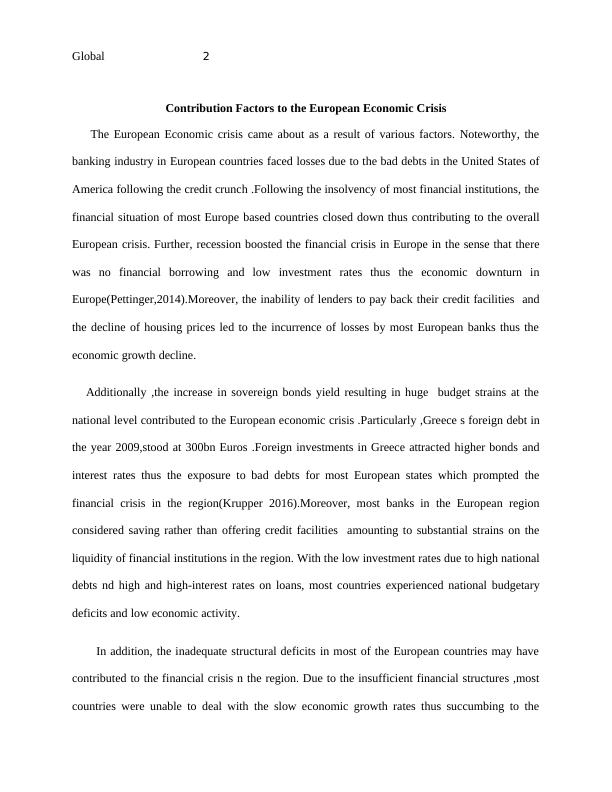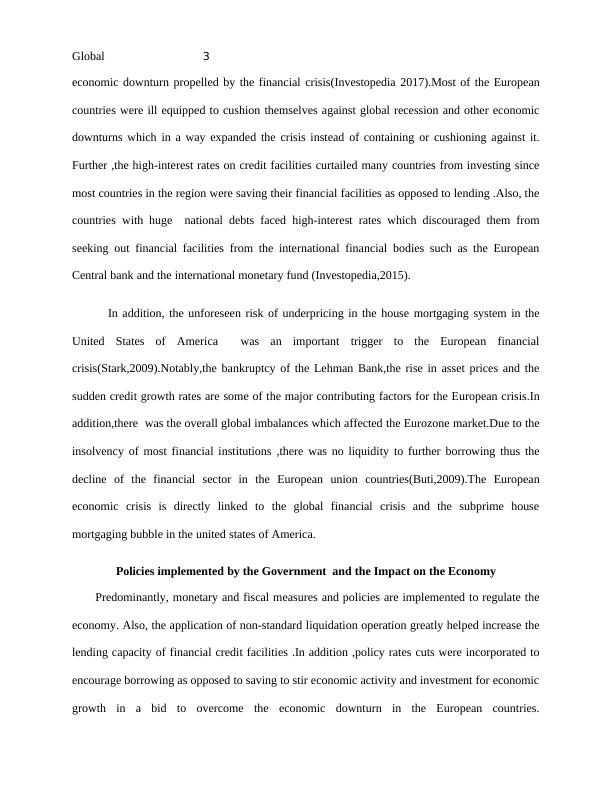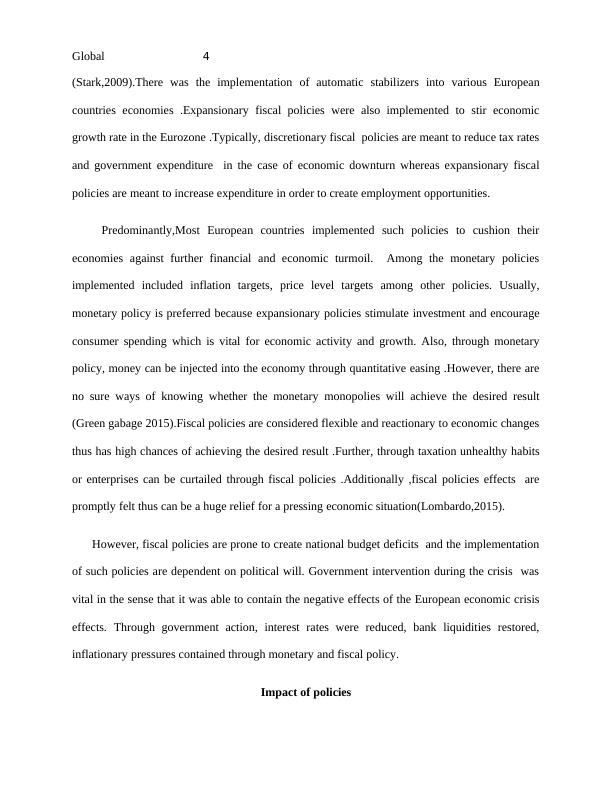Report On European Economic Crisis
12 Pages2960 Words30 Views
Added on 2020-02-24
Report On European Economic Crisis
Added on 2020-02-24
ShareRelated Documents
Global 1
GLOBAL BUSINESS AND ENVIRONMENTAL RISK
Students Name
Course
Professor’s name
University
(City)State
Date
GLOBAL BUSINESS AND ENVIRONMENTAL RISK
Students Name
Course
Professor’s name
University
(City)State
Date

Global 2
Contribution Factors to the European Economic Crisis
The European Economic crisis came about as a result of various factors. Noteworthy, the
banking industry in European countries faced losses due to the bad debts in the United States of
America following the credit crunch .Following the insolvency of most financial institutions, the
financial situation of most Europe based countries closed down thus contributing to the overall
European crisis. Further, recession boosted the financial crisis in Europe in the sense that there
was no financial borrowing and low investment rates thus the economic downturn in
Europe(Pettinger,2014).Moreover, the inability of lenders to pay back their credit facilities and
the decline of housing prices led to the incurrence of losses by most European banks thus the
economic growth decline.
Additionally ,the increase in sovereign bonds yield resulting in huge budget strains at the
national level contributed to the European economic crisis .Particularly ,Greece s foreign debt in
the year 2009,stood at 300bn Euros .Foreign investments in Greece attracted higher bonds and
interest rates thus the exposure to bad debts for most European states which prompted the
financial crisis in the region(Krupper 2016).Moreover, most banks in the European region
considered saving rather than offering credit facilities amounting to substantial strains on the
liquidity of financial institutions in the region. With the low investment rates due to high national
debts nd high and high-interest rates on loans, most countries experienced national budgetary
deficits and low economic activity.
In addition, the inadequate structural deficits in most of the European countries may have
contributed to the financial crisis n the region. Due to the insufficient financial structures ,most
countries were unable to deal with the slow economic growth rates thus succumbing to the
Contribution Factors to the European Economic Crisis
The European Economic crisis came about as a result of various factors. Noteworthy, the
banking industry in European countries faced losses due to the bad debts in the United States of
America following the credit crunch .Following the insolvency of most financial institutions, the
financial situation of most Europe based countries closed down thus contributing to the overall
European crisis. Further, recession boosted the financial crisis in Europe in the sense that there
was no financial borrowing and low investment rates thus the economic downturn in
Europe(Pettinger,2014).Moreover, the inability of lenders to pay back their credit facilities and
the decline of housing prices led to the incurrence of losses by most European banks thus the
economic growth decline.
Additionally ,the increase in sovereign bonds yield resulting in huge budget strains at the
national level contributed to the European economic crisis .Particularly ,Greece s foreign debt in
the year 2009,stood at 300bn Euros .Foreign investments in Greece attracted higher bonds and
interest rates thus the exposure to bad debts for most European states which prompted the
financial crisis in the region(Krupper 2016).Moreover, most banks in the European region
considered saving rather than offering credit facilities amounting to substantial strains on the
liquidity of financial institutions in the region. With the low investment rates due to high national
debts nd high and high-interest rates on loans, most countries experienced national budgetary
deficits and low economic activity.
In addition, the inadequate structural deficits in most of the European countries may have
contributed to the financial crisis n the region. Due to the insufficient financial structures ,most
countries were unable to deal with the slow economic growth rates thus succumbing to the

Global 3
economic downturn propelled by the financial crisis(Investopedia 2017).Most of the European
countries were ill equipped to cushion themselves against global recession and other economic
downturns which in a way expanded the crisis instead of containing or cushioning against it.
Further ,the high-interest rates on credit facilities curtailed many countries from investing since
most countries in the region were saving their financial facilities as opposed to lending .Also, the
countries with huge national debts faced high-interest rates which discouraged them from
seeking out financial facilities from the international financial bodies such as the European
Central bank and the international monetary fund (Investopedia,2015).
In addition, the unforeseen risk of underpricing in the house mortgaging system in the
United States of America was an important trigger to the European financial
crisis(Stark,2009).Notably,the bankruptcy of the Lehman Bank,the rise in asset prices and the
sudden credit growth rates are some of the major contributing factors for the European crisis.In
addition,there was the overall global imbalances which affected the Eurozone market.Due to the
insolvency of most financial institutions ,there was no liquidity to further borrowing thus the
decline of the financial sector in the European union countries(Buti,2009).The European
economic crisis is directly linked to the global financial crisis and the subprime house
mortgaging bubble in the united states of America.
Policies implemented by the Government and the Impact on the Economy
Predominantly, monetary and fiscal measures and policies are implemented to regulate the
economy. Also, the application of non-standard liquidation operation greatly helped increase the
lending capacity of financial credit facilities .In addition ,policy rates cuts were incorporated to
encourage borrowing as opposed to saving to stir economic activity and investment for economic
growth in a bid to overcome the economic downturn in the European countries.
economic downturn propelled by the financial crisis(Investopedia 2017).Most of the European
countries were ill equipped to cushion themselves against global recession and other economic
downturns which in a way expanded the crisis instead of containing or cushioning against it.
Further ,the high-interest rates on credit facilities curtailed many countries from investing since
most countries in the region were saving their financial facilities as opposed to lending .Also, the
countries with huge national debts faced high-interest rates which discouraged them from
seeking out financial facilities from the international financial bodies such as the European
Central bank and the international monetary fund (Investopedia,2015).
In addition, the unforeseen risk of underpricing in the house mortgaging system in the
United States of America was an important trigger to the European financial
crisis(Stark,2009).Notably,the bankruptcy of the Lehman Bank,the rise in asset prices and the
sudden credit growth rates are some of the major contributing factors for the European crisis.In
addition,there was the overall global imbalances which affected the Eurozone market.Due to the
insolvency of most financial institutions ,there was no liquidity to further borrowing thus the
decline of the financial sector in the European union countries(Buti,2009).The European
economic crisis is directly linked to the global financial crisis and the subprime house
mortgaging bubble in the united states of America.
Policies implemented by the Government and the Impact on the Economy
Predominantly, monetary and fiscal measures and policies are implemented to regulate the
economy. Also, the application of non-standard liquidation operation greatly helped increase the
lending capacity of financial credit facilities .In addition ,policy rates cuts were incorporated to
encourage borrowing as opposed to saving to stir economic activity and investment for economic
growth in a bid to overcome the economic downturn in the European countries.

Global 4
(Stark,2009).There was the implementation of automatic stabilizers into various European
countries economies .Expansionary fiscal policies were also implemented to stir economic
growth rate in the Eurozone .Typically, discretionary fiscal policies are meant to reduce tax rates
and government expenditure in the case of economic downturn whereas expansionary fiscal
policies are meant to increase expenditure in order to create employment opportunities.
Predominantly,Most European countries implemented such policies to cushion their
economies against further financial and economic turmoil. Among the monetary policies
implemented included inflation targets, price level targets among other policies. Usually,
monetary policy is preferred because expansionary policies stimulate investment and encourage
consumer spending which is vital for economic activity and growth. Also, through monetary
policy, money can be injected into the economy through quantitative easing .However, there are
no sure ways of knowing whether the monetary monopolies will achieve the desired result
(Green gabage 2015).Fiscal policies are considered flexible and reactionary to economic changes
thus has high chances of achieving the desired result .Further, through taxation unhealthy habits
or enterprises can be curtailed through fiscal policies .Additionally ,fiscal policies effects are
promptly felt thus can be a huge relief for a pressing economic situation(Lombardo,2015).
However, fiscal policies are prone to create national budget deficits and the implementation
of such policies are dependent on political will. Government intervention during the crisis was
vital in the sense that it was able to contain the negative effects of the European economic crisis
effects. Through government action, interest rates were reduced, bank liquidities restored,
inflationary pressures contained through monetary and fiscal policy.
Impact of policies
(Stark,2009).There was the implementation of automatic stabilizers into various European
countries economies .Expansionary fiscal policies were also implemented to stir economic
growth rate in the Eurozone .Typically, discretionary fiscal policies are meant to reduce tax rates
and government expenditure in the case of economic downturn whereas expansionary fiscal
policies are meant to increase expenditure in order to create employment opportunities.
Predominantly,Most European countries implemented such policies to cushion their
economies against further financial and economic turmoil. Among the monetary policies
implemented included inflation targets, price level targets among other policies. Usually,
monetary policy is preferred because expansionary policies stimulate investment and encourage
consumer spending which is vital for economic activity and growth. Also, through monetary
policy, money can be injected into the economy through quantitative easing .However, there are
no sure ways of knowing whether the monetary monopolies will achieve the desired result
(Green gabage 2015).Fiscal policies are considered flexible and reactionary to economic changes
thus has high chances of achieving the desired result .Further, through taxation unhealthy habits
or enterprises can be curtailed through fiscal policies .Additionally ,fiscal policies effects are
promptly felt thus can be a huge relief for a pressing economic situation(Lombardo,2015).
However, fiscal policies are prone to create national budget deficits and the implementation
of such policies are dependent on political will. Government intervention during the crisis was
vital in the sense that it was able to contain the negative effects of the European economic crisis
effects. Through government action, interest rates were reduced, bank liquidities restored,
inflationary pressures contained through monetary and fiscal policy.
Impact of policies

End of preview
Want to access all the pages? Upload your documents or become a member.
Related Documents
European Financial Crisis: Causes, Impacts, and Mitigation Strategieslg...
|6
|1521
|50
Factors That Led Up To the Global Banking Crisis 2007/09lg...
|4
|724
|62
The Eurozone Crisis | European Debt Crisislg...
|5
|1130
|14
European Sovereign Debt Crisis Report Assignmentlg...
|10
|2260
|199
The EuropEAN DeBT Crisis TABLE OF CONTENTSlg...
|11
|2577
|288
Assignment Finance: Financial Operationslg...
|7
|1631
|70
